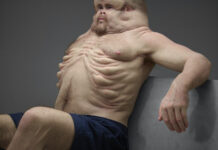A sculpture machine – this is how an artist sees a 3D printer. To furniture designer, architect, and artist Alejandro Estrada, his 3D printer is a tool on par with a hammer and chisel. He didn’t choose this method because it was faster, cheaper, or easier. He creates with a 3D printer because it expands what’s possible in design and challenges his imagination.
“When you know how to draw a line it’s completely unimportant if it’s with a stick, with your hand, with a pencil, or with a computer,” he says. “And when you know how to draw a line and you find much more accurate ways of doing so, then you take this new way of doing to create a work of art.”
Estrada’s 3D printed furniture isn’t just an expression of art, it’s an expression of additive manufacturing technology itself because he only produces pieces that can’t be made any other way. “If it looks like you can do it with your hands or it can be done with another machine, then I think it doesn’t make any sense to 3D print it,” he says.
Some designers might imagine a chair then look for a unique way to produce it. Instead, Estrada begins with the method – the 3D printer – and then, with an intimate understanding of its capabilities, imagines what type of chair only it could produce.
And with this approach the Truss line of outdoor furniture was born. Retailing in exclusive designer furniture galleries in New York, Miami, and Los Angeles, each piece of Estrada’s furniture created by his company, Piegatto, is a solid, intricate object of art that is as beautiful as it is comfortable. Printed from biodegradable and weatherproof PLA with openings that create transparency, the chair stretches in some parts and stays sturdy in others.
Not many 3D printers are capable of producing prints at this level of complexity and size, and finding the right printer took Estrada time and testing.
More commonly used in injection molding, pellets are not only less expensive but come in a wider range of materials than filament, including a long list of recycled and sustainable products. Plus, because a high volume of pellet material is fed via a hopper into the extruder, pellet-based 3D printers typically can print large objects quicker than filament-based printers.
Sustainability is an important aspect of Piegatto’s designs. Not only should the furniture be made of sustainable materials but the process should create little waste, which is a hallmark of additive manufacturing.
For Estrada, 3D printing is a way to add even more beauty to an object. “We realized that we needed to do wise objects without waste, as the beauty of an object not only resides in what you see as a final product, but what … you practice in achieving that beauty.”
Analysis
This is the second article I have pulled on the topic of 3D printing, but instead of taking a scientific angle, it’s important to see this method of manufacturing as an art. I think it’s quite beautiful knowing how the different geometric pieces all work together as quite calculated mathematical trusses. The story of this artist is also inspiring, to know that he works with biodegradable materials while making them weatherproof as well. I think considering 3D printed furniture for the Dayton design is still a very strong contender, since it can be large or small, as well as modular. Creating a dynamic space might be important for professionals who might all use their space slightly differently. I think using a printed design might also be easier to incorporate historical representations of the community right into the furniture pieces. Even if the furniture does not end up being 3D printed, it could be interesting to use it somewhere unexpected in the design.




